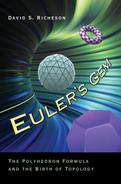Book Description
Leonhard Euler's polyhedron formula describes the structure of many objects--from soccer balls and gemstones to Buckminster Fuller's buildings and giant all-carbon molecules. Yet Euler's formula is so simple it can be explained to a child. Euler's Gem tells the illuminating story of this indispensable mathematical idea.
From ancient Greek geometry to today's cutting-edge research, Euler's Gem celebrates the discovery of Euler's beloved polyhedron formula and its far-reaching impact on topology, the study of shapes. In 1750, Euler observed that any polyhedron composed of V vertices, E edges, and F faces satisfies the equation V-E+F=2. David Richeson tells how the Greeks missed the formula entirely; how Descartes almost discovered it but fell short; how nineteenth-century mathematicians widened the formula's scope in ways that Euler never envisioned by adapting it for use with doughnut shapes, smooth surfaces, and higher dimensional shapes; and how twentieth-century mathematicians discovered that every shape has its own Euler's formula. Using wonderful examples and numerous illustrations, Richeson presents the formula's many elegant and unexpected applications, such as showing why there is always some windless spot on earth, how to measure the acreage of a tree farm by counting trees, and how many crayons are needed to color any map.
Filled with a who's who of brilliant mathematicians who questioned, refined, and contributed to a remarkable theorem's development, Euler's Gem will fascinate every mathematics enthusiast.
Table of Contents
- Cover
- Half title
- Title
- Copyright
- Dedication
- Contents
- Preface
- Introduction
- Chapter 1 Leonhard Euler and His Three “Great” Friends
- Chapter 2 What Is a Polyhedron?
- Chapter 3 The Five Perfect Bodies
- Chapter 4 The Pythagorean Brotherhood and Plato’s Atomic Theory
- Chapter 5 Euclid and His Elements
- Chapter 6 Kepler’s Polyhedral Universe
- Chapter 7 Euler’s Gem
- Chapter 8 Platonic Solids, Golf Balls, Fullerenes, and Geodesic Domes
- Chapter 9 Scooped by Descartes?
- Chapter 10 Legendre Gets It Right
- Chapter 11 A Stroll through Königsberg
- Chapter 12 Cauchy’s Flattened Polyhedra
- Chapter 13 Planar Graphs, Geoboards, and Brussels Sprouts
- Chapter 14 It’s a Colorful World
- Chapter 15 New Problems and New Proofs
- Chapter 16 Rubber Sheets, Hollow Doughnuts, and Crazy Bottles
- Chapter 17 Are They the Same, or Are They Different?
- Chapter 18 A Knotty Problem
- Chapter 19 Combing the Hair on a Coconut
- Chapter 20 When Topology Controls Geometry
- Chapter 21 The Topology of Curvy Surfaces
- Chapter 22 Navigating in n Dimensions
- Chapter 23 Henri Poincaré and the Ascendance of Topology
- Epilogue The Million-Dollar Question
- Acknowledgements
- Appendix A Build Your Own Polyhedra and Surfaces
- Appendix B Recommended Readings
- Notes
- References
- Illustrations Credits
- Index
